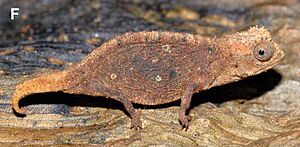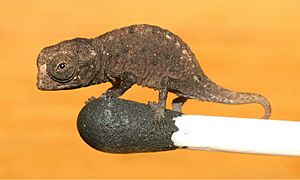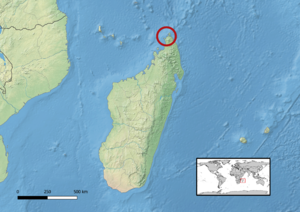Nosy Hara leaf chameleon facts for kids
Quick facts for kids Nosy Hara leaf chameleon |
|
|---|---|
 |
|
 |
|
| Adult female in natural habitat (top), juvenile on match head (bottom) | |
| Conservation status | |
| Scientific classification | |
| Genus: |
Brookesia
|
| Species: |
micra
|
 |
|
Brookesia micra, also called the Nosy Hara leaf chameleon, is a super tiny type of chameleon. It lives on a small island called Nosy Hara in Madagascar. When it was first found, it was the smallest known chameleon. It was also one of the tiniest reptiles on Earth. In 2021, an even smaller chameleon, B. nana, was discovered. Adult B. micra chameleons can grow up to about 29 millimeters (just over an inch) long.
Contents
Discovering the Tiny Chameleon
Brookesia micra was found and named by a group of scientists. This team was led by Frank Glaw from the Bavarian State Collection of Zoology. Glaw and his team had been exploring the forests of Madagascar for eight years. They were looking for new animals. Before being officially named, these chameleons were known as Brookesia sp. "Nosy Hara" in 2007.
What "Micra" Means
The second part of its name, micra, comes from a Greek word. "Mikros" means "tiny" or "small." This name perfectly describes the chameleon's very small body size.
Meet the Smallest Chameleon
Male Brookesia micra chameleons are very small. Their bodies, not counting the tail, are only about 16 millimeters long. The total length of both males and females is less than 30 millimeters. This makes them among the smallest amniote animals in the world. Amniotes are animals like reptiles, birds, and mammals.
Compared to another tiny chameleon, Brookesia minima, B. micra has a shorter tail. It also has a larger head. Adult B. micra chameleons have orange tails. This is different from the plain brown tails of Brookesia minima. The small size of this lizard might be because of where it lives. Sometimes, animals on small islands become smaller over time. This is called insular dwarfism.
Where These Chameleons Live
Brookesia micra was found in northern Madagascar in 2005. It was discovered on a small island in the Nosy Hara group. This island is not inhabited by people. During the day, these chameleons usually hide in leaf litter on the ground. At night, they climb up into tree branches to sleep. They can climb as high as 10 centimeters (about 4 inches).
Their homes are often in areas with special rock formations called tsingy. Tsingy are sharp limestone rocks. These rocks might help keep the area moist. They also offer protection from animals that might try to eat them. Tsingy is a very common feature in their habitat. B. micra chameleons also prefer higher places, like hills 500 to 700 meters high. They also like sloped ground, which helps water drain away.
Protecting Their Home
The area where B. micra lives is facing a problem. People are cutting down trees illegally. This can cause the chameleons to lose their homes. Scientists like Jorn Köhler say this makes the species "sensitive to habitat destruction." Because B. micra needs a very specific type of home, it is at high risk. If their habitat is destroyed, they could face extinction. Protecting their special island home is very important.
See also

- In Spanish: Brookesia micra para niños


